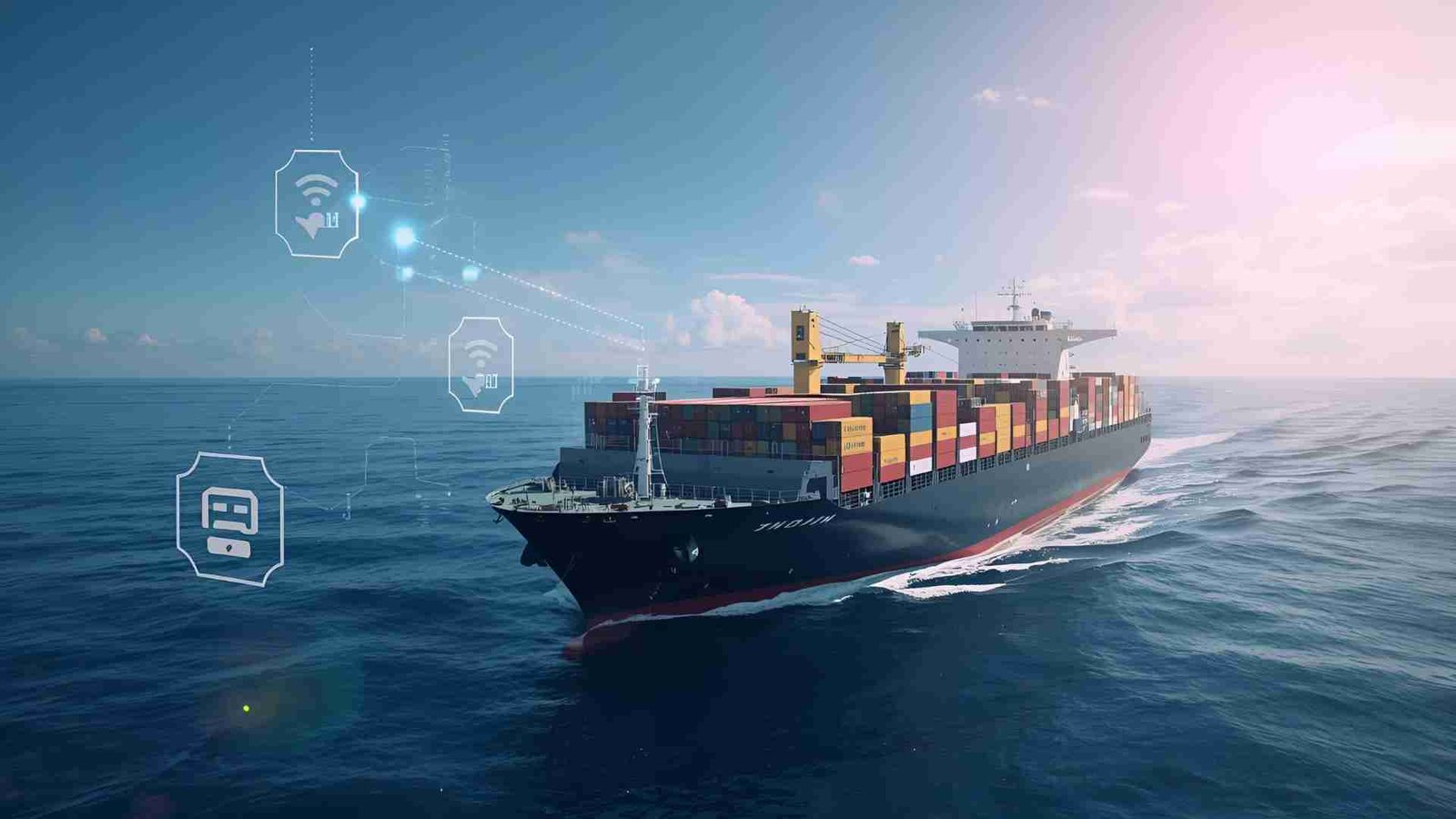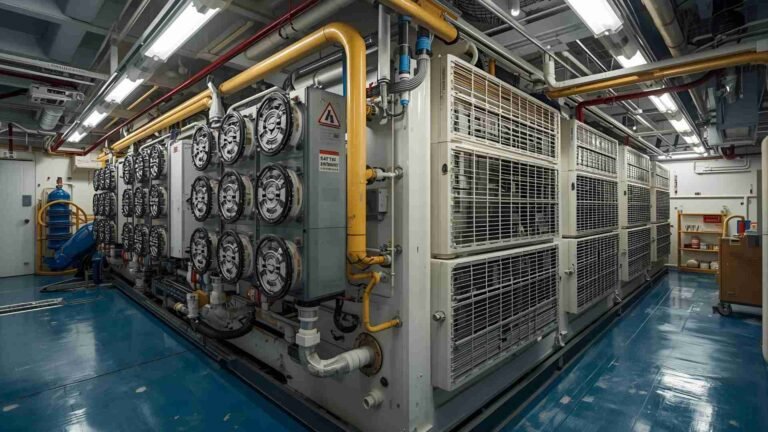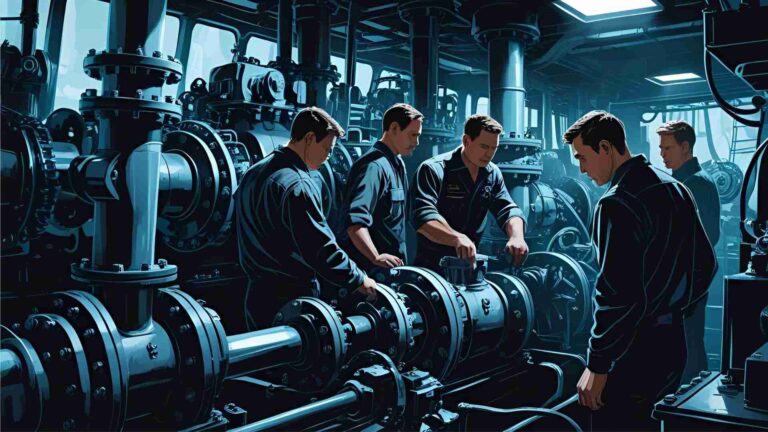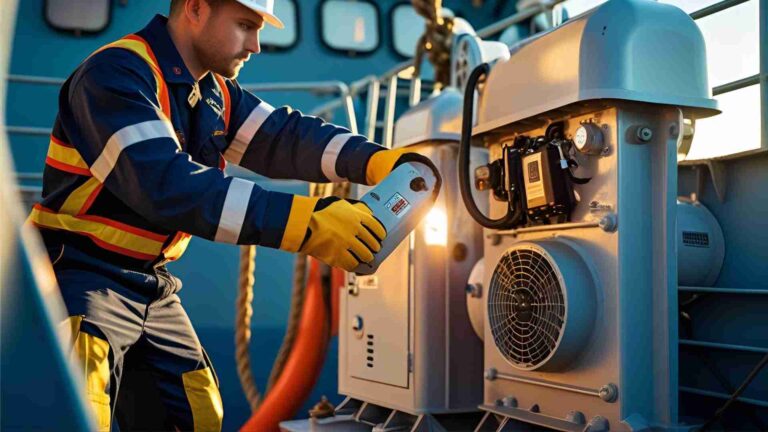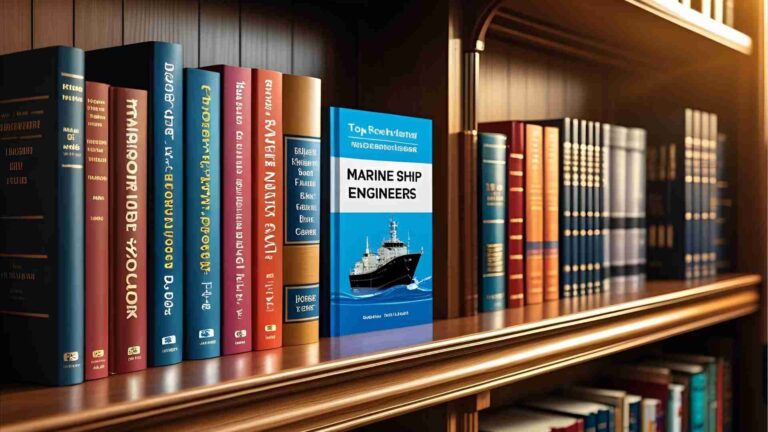Sensors and IoT in the Maritime Industry
Understanding Sensors and IoT in Maritime Context
Sensors are devices that detect and measure physical properties such as temperature, pressure, vibration, humidity, or location. In the shipping industry, they are embedded in ships, containers, and port infrastructure to monitor conditions in real time. The Internet of Things (IoT) connects these sensors into a network, allowing data to be collected, transmitted, and analyzed across devices and systems. This interconnected ecosystem enables automation, predictive analytics, and data-driven decision-making, transforming maritime operations.
The shipping industry, which handles approximately 90% of global trade, faces challenges like operational inefficiencies, safety risks, and stringent environmental regulations. Sensors and IoT address these by providing real-time insights and automation capabilities. For example, sensors on a ship’s engine can detect overheating, while IoT systems analyze this data to recommend maintenance, preventing costly breakdowns. The integration of low-cost, energy-efficient, and robust sensors—capable of self-calibration and wireless communication—has made this technology scalable and practical for widespread adoption.
Deeper Dive into Key Applications
1. Vessel Performance Monitoring and Optimization
Sensors monitor critical systems like propulsion, fuel systems, and navigation equipment. For instance, flow meters measure fuel consumption, while accelerometers detect engine vibrations. IoT platforms aggregate this data to optimize performance.
A practical example is a container ship reducing fuel use by 15% after IoT systems adjusted throttle settings based on real-time sea current and weather data. This not only lowers costs but also reduces greenhouse gas emissions, aligning with global sustainability goals.
2. Predictive Maintenance and Condition Monitoring
Predictive maintenance relies on sensors to track equipment health. Vibration sensors, for example, can detect subtle changes in a propeller shaft, signaling wear before failure occurs. IoT analytics use machine learning to predict when maintenance is needed, reducing downtime by up to 50% in some cases. A real-world case is a shipping company saving $500,000 annually by scheduling maintenance based on IoT data rather than fixed intervals.
3. Fleet Management and Asset Tracking
IoT-enabled GPS sensors track ships and containers, providing real-time location and status updates. This is critical for managing global supply chains. For instance, a logistics firm can reroute a vessel to avoid a storm, saving time and ensuring cargo safety. IoT also enables container tracking, with sensors monitoring temperature and humidity for perishable goods, reducing spoilage rates by 20% in refrigerated containers.
4. Navigation and Route Optimization
IoT systems integrate data from sensors monitoring weather, sea currents, and vessel speed to optimize routes. For example, a ship traveling from Shanghai to Rotterdam can save 10% on fuel by avoiding turbulent waters, as calculated by IoT analytics. This improves safety by reducing the risk of accidents in adverse conditions.
5. Safety and Security
Sensors like gas detectors and motion sensors enhance safety by identifying hazards like leaks or unauthorized access. IoT systems trigger automated alerts, such as activating fire suppression systems. In ports, cameras and RFID tags secure cargo, reducing theft by 30% in some facilities.
6. Smart Port Operations
Ports use IoT to automate tasks like berth allocation and container handling. Sensors on cranes track load weights, optimizing operations and reducing wait times by 25%. The Port of Rotterdam, for example, uses IoT to manage vessel traffic, cutting congestion and boosting throughput.
7. Environmental Monitoring
Sensors measure emissions, water quality, and ballast water conditions to ensure compliance with regulations like those from the International Maritime Organization (IMO). IoT systems analyze this data to minimize environmental impact, helping ships avoid fines averaging $100,000 per violation.
Technical Details of IoT Technologies
1. Sensors and Data Acquisition
Maritime sensors must withstand harsh conditions like saltwater corrosion and extreme temperatures. For example, the DS18B20 temperature sensor, priced at $5–20, offers ±0.5°C accuracy and waterproofing, ideal for monitoring refrigerated containers. GPS modules like the NEO-6M ($15–40) provide 2.5-meter accuracy, crucial for tracking.
2. Wireless Communication
Wi-Fi and 5G ensure high-speed data transfer in ports, while satellite systems like Inmarsat provide connectivity at sea. 5G’s low latency (under 1ms) supports real-time applications like autonomous navigation.
3. Data Analytics and Machine Learning
Machine learning models analyze sensor data to predict failures. For instance, a neural network might use historical vibration data to forecast engine issues with 90% accuracy. AI also enhances route planning by integrating weather forecasts.
4. Cloud and Edge Computing
Cloud platforms like AWS IoT store data for long-term analysis, while edge computing on ships processes time-sensitive data, reducing latency by 70% in remote areas.
5. Cybersecurity
Encryption (e.g., AES-256) and secure protocols like MQTT protect data. Regular firmware updates mitigate risks, but a single breach could cost millions in downtime or cargo loss.
Benefits
1. Cost Savings
Sensors and IoT optimize operations, reducing fuel consumption by 10–20% through real-time route adjustments based on weather and sea current data. For a large container ship, this can save $1M annually in fuel costs.
Predictive maintenance, enabled by sensors monitoring engine health, cuts maintenance expenses by up to 30% by preventing unexpected breakdowns. For example, a fleet of 10 ships could save $3M yearly. The return on investment (ROI) for IoT systems, costing $50K–$500K per vessel, is often achieved within 2 years due to these savings.
Additional Impact: Lower operational costs enhance competitiveness in global trade.
2. Safety Improvements
IoT systems provide real-time alerts for hazards like gas leaks or equipment failures, reducing accident rates by up to 50%. For instance, temperature sensors can detect engine overheating, triggering automatic shutdowns to prevent fires. This saves lives and cuts insurance premiums by 10–15%, as insurers reward safer operations. In ports, IoT-enabled cameras and motion sensors reduce cargo theft by 30%, ensuring secure supply chains.
Additional Impact: Enhanced safety improves crew morale and regulatory compliance, avoiding fines up to $100K per incident.
3. Sustainability
IoT optimizes routes and monitors fuel use, lowering CO2 emissions by 15%, aligning with the International Maritime Organization’s (IMO) 2050 goal of halving maritime emissions.
Sensors track emissions and ballast water, ensuring compliance with environmental regulations and avoiding fines averaging $100K per violation. For example, a shipping company reduced its carbon footprint by 20,000 tons annually using IoT-driven analytics.
Additional Impact: Sustainable practices enhance brand reputation and attract eco-conscious clients.
Challenges
1. Data Overload
A single ship generates up to 1TB of data daily from sensors tracking engines, cargo, and navigation. This overwhelms storage and processing systems, especially when integrating with outdated legacy systems, which may require upgrades costing $100K–$500K per ship. Delays in data processing can miss critical alerts, leading to downtime costing $50K/day.
Solutions: Use cloud platforms (e.g., AWS IoT) for scalable storage, edge computing to reduce latency by 70%, and data compression to prioritize critical data.
2. Regulatory Hurdles
Compliance with varying standards from the International Maritime Organization (IMO) and regional bodies complicates global operations. For example, emissions regulations differ across regions, requiring adaptable IoT systems. Standardization is slow, hindering interoperability.
Solutions: Adopt flexible IoT platforms that support multiple regulatory frameworks and engage with industry groups to push for unified standards.
3. Cybersecurity Risks
IoT networks are vulnerable to cyberattacks, like a 2020 incident that cost a shipping firm $300M due to weeks of disruption. Data breaches can compromise cargo security or operational systems.
Solutions: Implement AES-256 encryption, secure MQTT protocols, and regular firmware updates to reduce risks by 80%.
4. Device Limitations
Sensors rely on constant power and internet. A network outage can halt monitoring, risking perishable cargo worth millions. Deployment costs ($50K–$500K/vessel) are high, and glitches may cause inaccurate data.
Solutions: Use low-power sensors (e.g., 2.7µA pressure sensors) and backup power systems to ensure reliability.
Future Trends and Innovations
1. Advanced Sensors
Next-gen sensors leverage nanotechnology and edge tech for miniaturization, delivering 10x accuracy and 50% less power use, ideal for harsh maritime environments. They enable precise monitoring of fuel, cargo conditions, and vibrations. In 2025, IoT sensors on vessels provide real-time data, cutting predictive maintenance needs by 20%.
Impact: Enables denser networks on ships, boosting data granularity without draining batteries.
2. 5G Integration
5G rollout enables autonomous ships with ultra-low latency (<1ms) and 99.9% uptime for data transmission, supporting remote control and fleet coordination. Private 5G networks in ports and offshore ops facilitate unmanned navigation and IoT scalability.
Impact: Reduces crew risks, optimizes routes in real-time, projecting $8.2B autonomous market by 2030.
3. Digital Twins
Virtual ship replicas integrate IoT sensors for real-time simulation, slashing build costs by 20% and enabling predictive ops like route optimization. Maersk and NAPA’s 2025 projects use twins for supply chain visibility and maintenance.
Impact: Minimizes downtime by 30%, transforms design with AI-enhanced models.
4. AI and Blockchain
AI refines predictive models from sensor data, forecasting failures with 95% accuracy; blockchain secures supply chain sharing, cutting fraud by 40%. In 2025, combos enable transparent cargo tracking via IoT.
Impact: Boosts efficiency, with blockchain market hitting $3.5B.
Practical Implications
1. Investment Costs for Shipowners
IoT adoption costs shipowners $50,000–$500,000 per vessel, covering sensors ($5–40/unit), data loggers ($1,000–$5,000), software ($10,000–$100,000/year), and installation ($20,000–$100,000). Fuel savings of 10–20% ($500K–$1M/year for large ships) and 30% lower maintenance costs yield ROI within 2 years.
Example: A 10,000 TEU ship invested $250,000 in IoT, saving $600,000 annually, recovering costs in 1.5 years.
2. Port Revenue Benefits
IoT reduces port congestion, boosting revenue by 10–15%. Sensors optimize crane and berth operations, cutting wait times by 25%.
Example: The Port of Rotterdam’s IoT system increased throughput by 12%, adding $10M in annual revenue.
3. Crew Training Needs
Crews need training to use IoT systems, costing $5,000–$20,000 per vessel for courses on data interpretation and system management. Untrained crews risk misusing data, reducing efficiency.
Example: A shipping firm trained 50 crew members for $15,000, improving system uptime by 20%.
4. Cybersecurity Requirements
IoT systems require robust cybersecurity (e.g., AES-256 encryption, MQTT protocols) to prevent breaches costing millions, like a 2020 attack causing $300M in losses. Regular updates and monitoring add $5,000–$50,000/year per ship.
Example: A fleet implementing cybersecurity saved $1M by avoiding a data breach.
Frequently Asked Questions
Sensors detect data like temperature or location, and IoT connects them to analyze and share data, optimizing vessel performance, cargo tracking, and port operations.
Sensors and IoT provide real-time data on fuel consumption, engine health, and vessel location, enabling shipping companies to optimize operations. For example, IoT systems can reduce fuel use by 10–20% through route optimization and cut maintenance costs by up to 30% with predictive analytics. This leads to streamlined fleet management, reduced downtime, and lower operational expenses.
Sensors detect hazards like gas leaks, while IoT enables real-time cargo tracking and automated alerts, reducing theft by 30% and ensuring safety compliance.
Challenges include managing massive data (1TB/day/ship), cybersecurity risks, regulatory differences, and high setup costs ($50K–$500K/vessel).
Sensors track emissions, water quality, and fuel use, while IoT analyzes this data to optimize routes and reduce fuel consumption by 15%, lowering greenhouse gas emissions.
This helps ships comply with strict regulations from bodies like the International Maritime Organization, avoiding fines averaging $100,000 per violation, and supports the industry’s goal of decarbonization by 2050.
Conclusion
Sensors and IoT are revolutionizing the shipping industry, driving efficiency, safety, and sustainability. Real-time data from sensors optimizes vessel performance, reduces fuel use by 15%, and enables predictive maintenance, cutting costs by up to 30%. IoT enhances security through cargo tracking and hazard detection, while supporting environmental compliance by monitoring emissions. Despite challenges like data management, cybersecurity risks, and high deployment costs, the technology’s benefits outweigh obstacles. As 5G, AI, and digital twins advance, IoT will further transform maritime operations, creating a smarter, greener, and more resilient industry, poised to meet global trade demands and sustainability goals effectively.
Happy Boating!
Share Sensors and IoT in the Shipping Industry with your friends and leave a comment below with your thoughts.
Read Air Compressors in Ships’ Engine Rooms until we meet in the next article.
